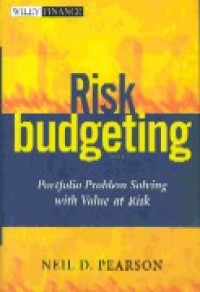
Risk budgeting : portfolio problem solving with value-at-risk
| Gmd : Text
| Availability :
| 00000009671 | HG4529.5 .P4 2002 REF | (Reference) | Available - Ada |
| 00000009870 | HG4529.5 .P4 2002 REF | (Reference) | Available - Ada |
Covers the hottest topic in investment for multitrillion pension market and institutional investors. Introduces VaR, extreme VaR, and stress-testing risk measurement techniques to major institutional investors, and shows them how they can implement formal risk budgeting to more efficiently manage their investment portfolios.
From the Inside Flap
Risk Budgeting
To successfully manage an investment portfolio, institutional investors and fund managers understand they must take risks to generate superior investment returns. The more complicated question is, "How much risk should they take?" In Risk Budgeting: Portfolio Problem Solving with Value-at-Risk, expert Neil Pearson introduces the concept of risk budgeting and describes the tools and techniques that underlie it, namely Value-at-Risk (VaR) and risk decomposition.
Risk Budgeting presents sophisticated ideas but avoids the use of high-level mathematics so you can easily understand the techniques and immediately begin to implement a formal risk budgeting plan. You?ll be able to more efficiently manage an investment portfolio that consists of everything from equities and bonds to commodities and derivatives.
Focusing strictly on the techniques for accomplishing risk budgeting, this comprehensive guide will give institutional investors, fund managers, and portfolio managers a complete working knowledge of VaR its use in measuring and identifying the risks of investment portfolios as well as its use in risk budgeting. Insightful case studies and useful charts illustrating examples of VaR, extreme VaR, and stress testing risk measurement techniques will help any professional look down the financial road and make proper adjustments, minimizing potential risk.
Step by step, Risk Budgeting takes you through the concept of risk budgeting as an investment process and VaR as a risk measurement technique:
Presenting the concepts of VaR in an equity portfolio and introducing the ways it can be used in risk decomposition and budgeting
Analyzing the approaches to computing VaR and creating scenarios for stress testing
Using VaR in risk budgeting
Recognizing the limitations of VaR
Finding and dealing with the risk of any type of portfolio has become increasingly difficult within the new financial environment. Improve your risk management skills with Risk Budgeting, and learn how VaR can be used as an integral part of your own risk management framework.
About the Author
NEIL D. PEARSON, PhD, is an Associate Professor of Finance at the University of Illinois at Urbana-Champaign. His research includes work on the development, estimation, and evaluation of models for pricing and hedging various derivatives and other financial instruments. Dr. Pearson has published papers in a number of academic journals, and is an Associate Editor of both the Journal of Financial Economics and the Journal of Financial and Quantitative Analysis. He has consulted for a number of U.S. and international banks, working on term structure models, the evaluation of derivatives pricing models, and issues that arise in the computation of Value-at-Risk measures. He received his PhD from the Massachusetts Institute of Technology.
Table of Contents:
Introduction
1. What are Value-at-Risk and Risk Budgeting?
2. A Simple Equity Portfolio
Techniques of Value-at-Risk and Stress Testing
3. The Delta-Normal Method
4. Historical Simulation
5. The Delta-Normal Method for a Fixed Income Portfolio
6. Monte Carlo Simulation
7. Using Factor Models to Compute the Value-at-Risk of Equity Portfolios
8. Using Principal Components to Compute the Value-at-Risk of Fixed Income Portfolios
9. Stress Testing
Risk Decomposition and Risk Budgeting
10. Decomposing Risk
11. A "Long-Short" Hedge Fund Manager
12. Aggregating and Decomposing the Risks of Large Portfolios
13. Risk Budgeting and the Choice of Active Managers
Refinements of the basic Methods
14. Delta-Gamma Approaches
15. Variants of the Monte Carlo Approach
16. Extreme Value Theory and VaR
Limitations of Value-at-Risk
17. VaR Is Only an Estimate
18. Gaming the VaR
19. Coherent Risk Measures
Conclusion
20. A Few Issues in Risk Budgeting
| Series Title |
Wiley Finance Series
|
|---|---|
| Call Number |
HG4529.5 .P4 2002 REF
|
| Publisher Place | New York |
| Collation |
x, 321p.; 24cm.
|
| Language |
English
|
| ISBN/ISSN |
0471405566
|
| Classification |
HG4529.5
|
| Media Type |
-
|
|---|---|
| Carrier Type |
-
|
| Edition |
-
|
| Subject(s) | |
| Specific Info |
-
|
| Statement |
-
|
| Content Type |
-
|
No other version available







